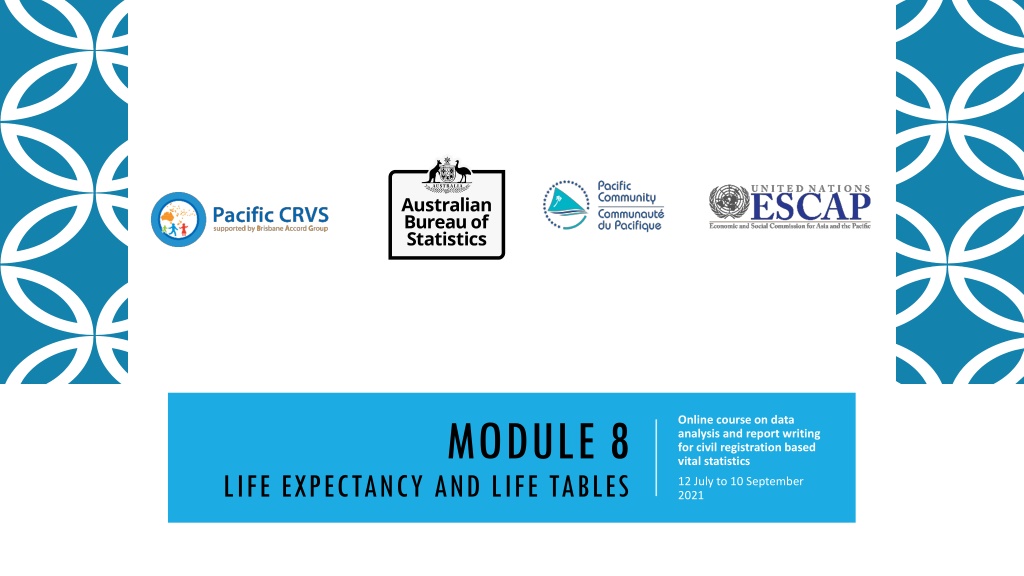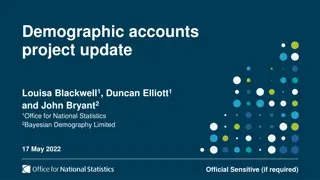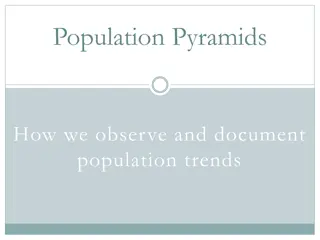Understanding Life Tables: Essential Tools in Demographic Analysis
Life tables are crucial tools in demography for analyzing mortality patterns and calculating life expectancy. They summarize mortality experiences of cohorts, provide insights on survival probabilities, and help estimate life expectancies for different populations. By constructing cohort and period life tables, demographers gain valuable information for various analyses beyond mortality. Explore the significance, construction, and applications of life tables in this comprehensive online course.
Download Presentation

Please find below an Image/Link to download the presentation.
The content on the website is provided AS IS for your information and personal use only. It may not be sold, licensed, or shared on other websites without obtaining consent from the author. Download presentation by click this link. If you encounter any issues during the download, it is possible that the publisher has removed the file from their server.
E N D
Presentation Transcript
MODULE 8 Online course on data analysis and report writing for civil registration based vital statistics LIFE EXPECTANCY AND LIFE TABLES 12 July to 10 September 2021
WHY DO WE CONSTRUCT LIFE TABLES? Essential tool in the demographer s toolbox. Used in the analysis of mortality and to calculate life expectancy . Also have wider application. Can be used for any kind of survival analysis (not just mortality), i.e. any data which comes in the form of varying durations of time between a definable start point and end point. Very useful for including data which may otherwise be lost due to censoring or loss to follow up.
WHAT IS A LIFE TABLE? A life table summarises a cohort s mortality experience Shows, for a person at each age, what the probability is that they will die before their next birthday. From this starting point, a number of statistics can be derived and thus also included in the table: the probability of surviving any particular year of age the remaining years someone can expect to live once they have reached a certain age the proportion of the original birth cohort still alive life expectancy Life tables are calculated separately for males and females because of their different mortality patterns.
COHORT LIFE TABLE Shows the probability of a person from a given cohort (e.g. all males born in 1900) dying at each age over the course of their lifetime. The cohort life table is based on age-specific probabilities of death, which are calculated using observed deaths data from the cohort. A cohort life table uses a combination of observed mortality rates for past years and projections about mortality rates for the cohort in future years (if they haven t all died yet). Cohort estimates of life expectancy are regarded as the most accurate measure of how long a person of a given age would be expected to live, compared to period life expectancy. In most cases, generation life tables are used to study historic periods.
PERIOD LIFE TABLE Use mortality rates from a single year (or group of years) and assume that those rates apply throughout the remainder of a person s life. Provides a cross-sectional view of mortality and survival experience Any future changes to mortality rates are not taken into account of that period ...what would happen to a cohort if it were subjected for all of its life to the mortality conditions It is what we call a synthetic or hypothetical cohort based on the mortality experience of a hypothetical cohort of newborn babies, usually 100,000 newborns, who are subject to the age-specific mortality rates on which the table is based. It traces the cohort of newborn babies throughout their lifetime under the assumption that they are subject to the age-specific mortality rates of a region or country. A more practical and useful tool for mortality analysis
LIFE TABLE ASSUMPTIONS 1. It uses a hypothetical closed population (migration in or out of the population is not considered) 2. People experience homogenous risks across age and time (which may not be the case, especially in the older age groups) 3. No measurement of change over time (over time survival within an age group gradually increases as people are in general, living longer, healthier lives)
HISTORY Established and old technique, first begun in the 17th century Natural and Political Observations upon the Bills of Mortality (1662) Implications of information obtained from christening and death lists in London
TYPES OF LIFE TABLE Multi-state and increment-decrement Single decrement Multiple decrement
ABRIDGED VS UNABRIDGED UNABRIDGED = single years of life (also known as complete) ABRIDGED = 5 year cohorts of life (but may be more aggregated if populations are small) In many countries, life tables are based on an average of age-specific death rates for a 3-year time period, generally around a census taking. In many cases, the life tables are prepared every 10 years. For example, a country or state would collect age-specific death rates for 1999, 2000, and 2001. The census for year 2000 would be used for the base population.
COMPLETE VS. ABRIDGED LIFE TABLE An abridged life table uses age groups*, based on the assumption that death rates are similar at neighboring ages. Where populations are very small ten year groupings may be used. A complete life table uses individual years of age *In most abridged life tables, it is good practice to set up using separate age groups for <1 year olds, 0-4 year olds, and the oldest ages as mortality patterns differ significantly during these ages. However, as shown in the table, where populations are small, it may be better to use a combined age group depending on population size and mortality patterns.
RATES VS RISK Rates and risk are often confused and it is made more difficult by the popular description of both as "rates". For instance infant mortality rate is a risk and not a true rate, but the terminology is unlikely to change. No. of favourable outcomes Probability = --------------------------------------------- Total no. of outcomes A true rate has a denominator of the average population across the interval concerned - or more accurately the person-years of exposure. The denominator is often described as "mid-term population" and this may be the origin of the term "central rate". Number of events in a certain period of time Rate = -------------------------------------------------------- Number of people who are exposed to the risk of experiencing that particular event in the given time period A risk is the same as a probability. It is the proportion of subjects affected by the event under study between the beginning and end of the interval. Therefore the events - the numerator - will be the same as the equivalent rate but the denominator will be the number of subjects at the start of the interval. Because this denominator will always be rather larger than the mid-term population - because none have experienced the event yet - the risk is always a bit smaller than the equivalent true rate. A probability (risk) can never be greater than 1. Under certain circumstances rates can exceed 1.
LIFE TABLE NOTATION The subscript BEFORE a symbol defines the width of the interval The subscript AFTER a symbol defines the starting point of the interval If there is no left subscript, then it will refer to an EXACT age x = exact age x, e.g. 40 n = width of interval, e.g 1, 5 or 10 years
LIFE TABLE COLUMNS: AGE INTERVAL (x, x+n) Age interval: age interval from exact age x to age x + n, e.g. exact age 40 to age 40 + 5
LIFE TABLE COLUMNS: nMx nMx: Age-specific death rate between the beginning of the age group x and the beginning of the next age group x+n e.g. the number of deaths of people aged exact age 40 to exact age 45 divided by the population of the same age group, over a defined period of time A capital M usually denotes the observed rates in the population A small m usually shows the rates used in the life table in age group x, x+n
LIFE TABLE COLUMNS: nqx nqx: (Conditional) probability of dying in the interval [x, x+n], given survival to age x, e.g. 5q40 is the probability of a person who has survived to age 40 surviving to exact age 45.
LIFE TABLE COLUMNS: lx lx: Number of survivors at exact age x l40 means the number of people surviving at exact age 40 First entry for age 0 = radix In the end, there lx must = 0, i.e. there are no survivors and can only decrease Probability of survival to exact age x = lx/l0
LIFE TABLE COLUMNS: ndx ndx: number of deaths in the interval [x, x+n] 5d40: number of people dying between exact age 40 and exact age 45 Follows a roughly similar pattern to nqx at younger ages but as numbers of survivors decrease, absolute numbers of deaths decreases
LIFE TABLE COLUMNS: nLx and Tx nLx: person-years lived between ages x, x+n 5L40: number of person- years lived between exact age 40 and 45 Tx: Total person-years lived above age x T40: number of person-years lived above exact age 40 Function of: Number of survivors (lx) Number of deaths (ndx) When in the interval people die on average (nax) Cumulative nLx (from bottom)
LIFE TABLE COLUMNS: ex ex: Expectation of life at exact age x = Average remaining lifetime for a person who survives to age x Most common is e0 = Life expectancy at birth = number of years a person can expect to live in his/her life with prevailing mortality rates But also life expectancy at other ages is important, e.g. e40 = Life expectancy at age 40 Calculated from cumulative life years from age x (Tx) divided by the number of survivors at age x (lx)
LIFE TABLE COLUMNS: nax nax = average life lived in the interval by those dying in the age interval [x,x+n] Problem deaths not linearly distributed in age interval, i.e. people don t die at that midpoint on average Often assumed to be the case but especially tricky for 0-1, 1-4 and oldest age group. Can model mortality function or use values from another population or assume all die at midpoint on average
nMx Age-specific mortality rate + Deaths during the year of persons between + age x to x n = M x Population aged x to x n Assume that nMx equal to nmx
Calculating nqx from nmx . n 1 m n x q n x + 1 .( ). n a m n x n x OK to use n/2 to estimate nax other than in the youngest age groups So for the standard 5 year age groups, nax = 2.5 What would it be for the oldest age group?
Calculating nax for the youngest age groups For older age groups, OK to use rule of thumb of n/2 but doesn t work for youngest The lower the level of mortality, the more concentrated deaths will be at the earlier stages of infancy Males Females Based on empirical evidence, these are the recommended nax values to be used Value of 1a0 If 1m0 0.107 If 1m0 0.107 Value of 4a1 If 1m0 0.107 If 1m0 0.107 0.330 0.350 0.045+2.684*1m0 0.053+2.800*1m0 1.352 1.361 1.651-2.816*1m0 1.522-1.518*1m0
npx Probability of surviving Definition: probability of surviving between exact age x and x+n = 1 + p q n x n q x = 1 p n x n x
lx Number of survivors at age x = l l p x x n n x n l0 =100,000 (everyone is alive in the beginning of the interval) For the last (open-ended) interval, the number of persons dying is the same as the number alive at its start: = d l + x x
nLx Number of person years lived between age x and x+n Each person who dies in an interval contributes a fraction of the interval equivalent to nax.n years nLx is obtained by averaging lx and lx+n and multiplying by the interval width, n Lx+ (the final age group) has no defined length and is calculated as such: l = x L x m x
Tx Number of person years lived from age x to the oldest age Computed by obtaining cumulative sum of nLx from the bottom (highest age interval) up: Refers to exact age x, not an age interval:
ex Period life expectancy at age x Definition: expected (average) number of years of life remaining for a person alive at the beginning of age interval x. On average, each of these lx individuals has approximately Tx/lx years to live: T e = x x l x
E0 The average number of years available to a newborn is generally referred to as the expectation of life at birth and is given by the ratio: T e = 0 0 l 0
ASSIGNMENT Using the mortality and population data provided for Oceania, compute 2 life tables for the female population in 1950-1955 and 2015-2020 in the Excel spreadsheet provided. Data for number of deaths and population estimates are provided Use Excel functions to compute estimates Solutions are provided in the spreadsheet so that you can check your answers Comparing the life table for the female population in Oceania between 1950- 1955 and 2015-2020, what do you notice (e.g. life expectancy)?























